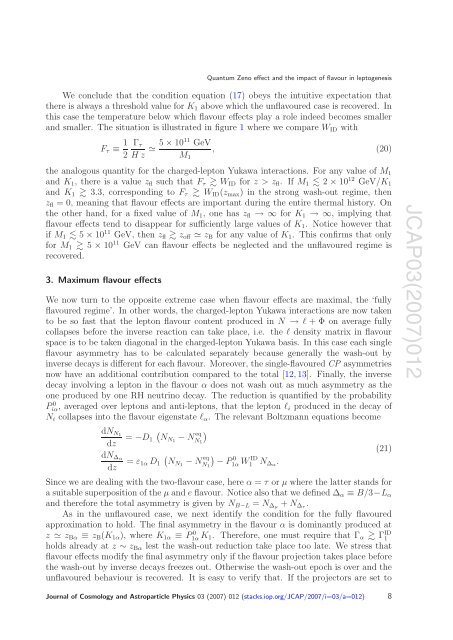Quantum Zeno effect and the impact of flavor in leptogenesis
Quantum Zeno effect and the impact of flavor in leptogenesis
Quantum Zeno effect and the impact of flavor in leptogenesis
You also want an ePaper? Increase the reach of your titles
YUMPU automatically turns print PDFs into web optimized ePapers that Google loves.
<strong>Quantum</strong> <strong>Zeno</strong> <strong>effect</strong> <strong>and</strong> <strong>the</strong> <strong>impact</strong> <strong>of</strong> flavour <strong>in</strong> <strong>leptogenesis</strong>We conclude that <strong>the</strong> condition equation (17) obeys <strong>the</strong> <strong>in</strong>tuitive expectation that<strong>the</strong>re is always a threshold value for K 1 above which <strong>the</strong> unflavoured case is recovered. Inthis case <strong>the</strong> temperature below which flavour <strong>effect</strong>s play a role <strong>in</strong>deed becomes smaller<strong>and</strong> smaller. The situation is illustrated <strong>in</strong> figure 1 where we compare W ID withF τ ≡ 1 2Γ τHz ≃ 5 × 1011 GeVM 1, (20)<strong>the</strong> analogous quantity for <strong>the</strong> charged-lepton Yukawa <strong>in</strong>teractions. For any value <strong>of</strong> M 1<strong>and</strong> K 1 , <strong>the</strong>re is a value z fl such that F τ W ID for z>z fl . If M 1 2 × 10 12 GeV/K 1<strong>and</strong> K 1 3.3, correspond<strong>in</strong>g to F τ W ID (z max ) <strong>in</strong> <strong>the</strong> strong wash-out regime, <strong>the</strong>nz fl = 0, mean<strong>in</strong>g that flavour <strong>effect</strong>s are important dur<strong>in</strong>g <strong>the</strong> entire <strong>the</strong>rmal history. On<strong>the</strong> o<strong>the</strong>r h<strong>and</strong>, for a fixed value <strong>of</strong> M 1 , one has z fl →∞for K 1 →∞, imply<strong>in</strong>g thatflavour <strong>effect</strong>s tend to disappear for sufficiently large values <strong>of</strong> K 1 . Notice however thatif M 1 5 × 10 11 GeV, <strong>the</strong>n z fl z <strong>of</strong>f ≃ z B for any value <strong>of</strong> K 1 . This confirms that onlyfor M 1 5 × 10 11 GeV can flavour <strong>effect</strong>s be neglected <strong>and</strong> <strong>the</strong> unflavoured regime isrecovered.3. Maximum flavour <strong>effect</strong>sWe now turn to <strong>the</strong> opposite extreme case when flavour <strong>effect</strong>s are maximal, <strong>the</strong> ‘fullyflavoured regime’. In o<strong>the</strong>r words, <strong>the</strong> charged-lepton Yukawa <strong>in</strong>teractions are now takento be so fast that <strong>the</strong> lepton flavour content produced <strong>in</strong> N → l + Φ on average fullycollapses before <strong>the</strong> <strong>in</strong>verse reaction can take place, i.e. <strong>the</strong> l density matrix <strong>in</strong> flavourspace is to be taken diagonal <strong>in</strong> <strong>the</strong> charged-lepton Yukawa basis. In this case each s<strong>in</strong>gleflavour asymmetry has to be calculated separately because generally <strong>the</strong> wash-out by<strong>in</strong>verse decays is different for each flavour. Moreover, <strong>the</strong> s<strong>in</strong>gle-flavoured CP asymmetriesnow have an additional contribution compared to <strong>the</strong> total [12, 13]. F<strong>in</strong>ally, <strong>the</strong> <strong>in</strong>versedecay <strong>in</strong>volv<strong>in</strong>g a lepton <strong>in</strong> <strong>the</strong> flavour α does not wash out as much asymmetry as <strong>the</strong>one produced by one RH neutr<strong>in</strong>o decay. The reduction is quantified by <strong>the</strong> probabilityPiα, 0 averaged over leptons <strong>and</strong> anti-leptons, that <strong>the</strong> lepton l i produced <strong>in</strong> <strong>the</strong> decay <strong>of</strong>N i collapses <strong>in</strong>to <strong>the</strong> flavour eigenstate l α . The relevant Boltzmann equations becomedN N1(= −D 1 NN1 − N eq )Ndz1dN Δαdz= ε 1α D 1(NN1 − N eqN 1)− P01α W ID1 N Δα .S<strong>in</strong>ce we are deal<strong>in</strong>g with <strong>the</strong> two-flavour case, here α = τ or μ where <strong>the</strong> latter st<strong>and</strong>s fora suitable superposition <strong>of</strong> <strong>the</strong> μ <strong>and</strong> e flavour. Notice also that we def<strong>in</strong>ed Δ α ≡ B/3−L α<strong>and</strong> <strong>the</strong>refore <strong>the</strong> total asymmetry is given by N B−L = N Δμ + N Δτ .As <strong>in</strong> <strong>the</strong> unflavoured case, we next identify <strong>the</strong> condition for <strong>the</strong> fully flavouredapproximation to hold. The f<strong>in</strong>al asymmetry <strong>in</strong> <strong>the</strong> flavour α is dom<strong>in</strong>antly produced atz ≃ z Bα ≡ z B (K 1α ), where K 1α ≡ P1α 0 K 1. Therefore, one must require that Γ α Γ ID1holds already at z ∼ z Bα lest <strong>the</strong> wash-out reduction take place too late. We stress thatflavour <strong>effect</strong>s modify <strong>the</strong> f<strong>in</strong>al asymmetry only if <strong>the</strong> flavour projection takes place before<strong>the</strong> wash-out by <strong>in</strong>verse decays freezes out. O<strong>the</strong>rwise <strong>the</strong> wash-out epoch is over <strong>and</strong> <strong>the</strong>unflavoured behaviour is recovered. It is easy to verify that. If <strong>the</strong> projectors are set to(21)JCAP03(2007)012Journal <strong>of</strong> Cosmology <strong>and</strong> Astroparticle Physics 03 (2007) 012 (stacks.iop.org/JCAP/2007/i=03/a=012) 8













